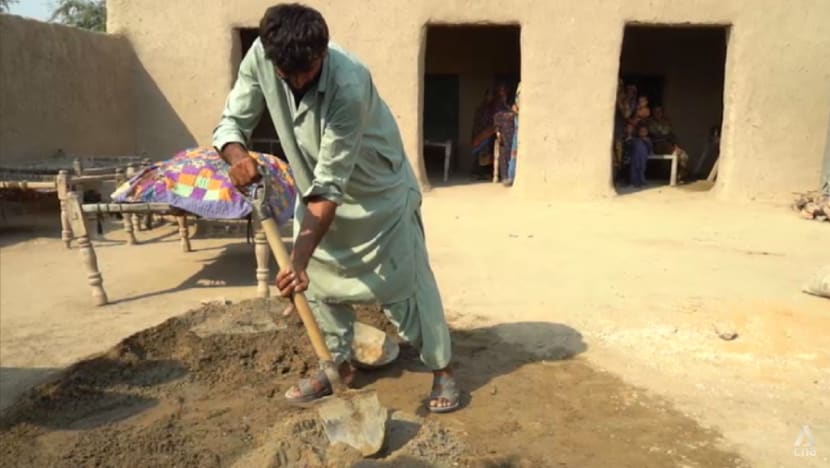Pakistan struggles to rebuild as millions of homes remain in ruins 2 years after deadly floods
Pakistan's government is constructing 2 million climate-resistant homes for flood victims but progress remains slow, hampered by funding delays.

Children walk on the rubble of a damaged building caused by floods in 2022, in Arzi Naich village in Dada, a district in Pakistan's Sindh province, May 17, 2023. Many children are still without schools as authorities struggle to repair the extensive damage. (Photo: AP/Anjum Naveed)

This audio is generated by an AI tool.
BADIN, Sindh: Resham Bibi lives in constant fear of her mud house collapsing on her and her family in the next heavy downpour.
As this year’s monsoon rains recede and with winter drawing near, the 80-year-old is racing against time to repair her dilapidated home in the flood-ravaged city of Badin.
Every fortnight, she dives into a pond to collect mud, which she mixes with straw to plaster and patch her walls, in hopes of prolonging the structural integrity of her house.
“We are scared that our home's weak roof and walls might fall upon us. Sometimes, water comes inside and we are scared our homes will be washed away again,” she told CNA.

Resham was among 33 million people impacted by catastrophic floods that wreaked havoc across Pakistan two years ago.
The unprecedented floods – caused by the heaviest monsoon rains in a decade – completely submerged one-third of the South Asian nation, washed away houses and roads, and triggered a humanitarian crisis.
Today, affected regions are still reeling from the climate-induced disaster as the country struggles to rebuild.
COMMUNITIES HIT BY FLOODS
Karen Reidy, chief of advocacy and communication at the United Nations Children's Fund (UNICEF) in Pakistan, said the devastation amplified the existing challenges and inequities faced by communities.
“Those kinds of issues are very hard to fix in the short term, especially when we don’t have the required funds,” she told CNA.

This rings especially true for Resham and her fellow residents in the southeastern province of Sindh, home to some of the hardest-hit areas that are still susceptible to seasonal floods from monsoon rains.
“(We take) whatever relief the government can offer to us. But if they don't provide it, we cannot force them. We are poor people, we are already in pain,” she said.
About 45 per cent of Sindh’s population live below the poverty line. Government estimates suggest that poverty rates in the region increased by as much as 10 per cent in the aftermath of the 2022 floods, plunging already-impoverished communities further into financial ruin.
BUILDING GREEN HOMES
The Sindh government is working with UNICEF and the World Bank to address one of the most urgent challenges facing those living in flood-prone areas: the need for sturdy, flood-resistant houses.
They are giving grants of about US$1,000 each to 2.1 million affected households in the province to help them build new homes.
Aside from being climate-resilient, the houses also aim to be more environmentally friendly.
Instead of using traditional materials such as mud and wood, the new houses will be built with concrete and bricks made from recycled plastic. The homes will be also equipped with solar energy.
One recipient of the grant is Nawab Khan, whose family lost everything in the disaster.
“The massive floods hit our homes. Our houses collapsed. They were damaged. We were forced to leave. We were on the roads. We were living in tents,” he told CNA.
He said he received about US$631 in two instalments under the government’s home building scheme.
To preserve the limited funds, Nawab is building the house himself and using the grant money solely to get construction materials.

FRUSTRATIONS OVER DELAYS
The new homes are built on elevated ground, with foundations of stones and bricks supplied by the local government.
So far, 300,000 of these climate-resistant homes have been completed, while half a million more are still under construction.
However, progress remains slow due to funding delays. Many residents in Badin said they are frustrated by hurdles in receiving government aid.
“We have just one request for the government: provide us with funds promptly so that we can build our homes quickly and move on from these wooden houses,” said Ramzan Khan, a local who survived the floods.
The rising costs of construction material is also forcing them to dip into their own meagre savings.
Sindh government spokesperson Ali Rashid said: “We have some issues going on with the federal government. A lot of funds which were supposed to come to us haven’t been released timely so that does have a trickle-down effect.”

Nawad and those with new houses are the lucky few in Badin. Countless others in flood-prone communities, including Resham, face constant fear of the next heavy rain.
As climate change drives more extreme weather events, many residents said climate anxiety has become a daily reality, and they are worried what the future may hold.
Pakistan is one of the most vulnerable countries to climate change, according to the Global Climate Risk Index, with a high exposure to floods and drought.
For those still anxiously waiting for a roof over their heads, they are calling on the government to urgently ramp up rebuilding efforts before another disaster strikes.













